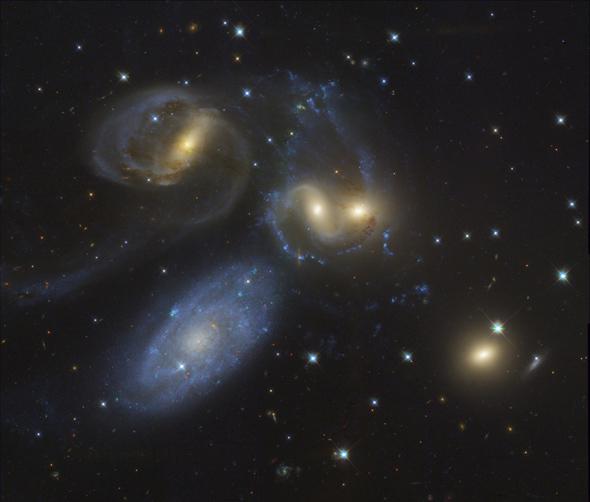shaileshs wrote: ↑Thu Apr 18, 2019 6:43 pm
Thank you Ann for your detailed response. It helps a lot.
Glad to be of some assistance!

I was going to write a private message to you, but that wasn't possible, so I'll write a bit more here about judging the intrinsic properties of a galaxy by simply looking at it.
Wide angle visible light image of the Tadpole galaxy.
Photo: KuriousGeorge.
The Tadpole galaxy and background galaxies.
The most interesting thing about the Hubble image of the Tadpole galaxy, in my opinion, is the wealth of background galaxies. You can use their appearance to make an educated guess about their intrinsic properties.
In the picture at left, you can see the brightest and most obvious of the background galaxies in the Tadpole galaxy picture. It defintely looks like an intrinsically large galaxy to me. Its bulge is large and bright, and its disk is large and well-formed, too. Note the dust lanes and the outer arms.
A fascinating tail seems to emanate from this galaxy. But if you look closely, a tiny object seems to be located right inside this tail. I'd say that this is a tiny satellite galaxy, and a long stream of stars has been pulled out of this galaxy by the mighty gravity of its large bully of a neighbour. And yes, the stellar stream doesn't just extend towards the large spiral galaxy, but it extends in the opposite direction too.
But wait. There is more. The outer end of the tail is curving, as if it has been caught in another gravitational field. What causes it? The two interacting yellow galaxies at left?
I'd say no. The two interacting yellow galaxies are just a shade too yellow to be at the same distance as the large spiral galaxy. I'd say that they are some distance in the background, far enough to be slightly affected by redshift-reddening. The farther away a galaxy is, the more its light will be reddened by the sheer expansion of space, which tugs at the wavelengths of light emitted by the galaxies and makes them appreciably longer by the time the light reaches us.
So the pair of yellow galaxies (which are intrinsically large by the look of their large bright centers) are not responsible for curving the stellar stream from the tiny satellite galaxy caught in the large spiral galaxy's powerful gravity.
But look at the galaxy above left. It is slightly less yellow than the two interacting yellow galaxies. And see how diffuse it is? And it's not very bright in the center.
In fact, this galaxy is much the same color as the large spiral galaxy, and it is certainly much the same color as the stellar stream. Because the colors are virtually identical, I'd say that this galaxy is at the same distance as the edge-on spiral galaxy. But it is clearly much smaller than the spiral galaxy.
So it seems extremely likely that the diffuse galaxy at upper left is another satellite galaxy of the spiral galaxy. Moreover, this diffuse galaxy could very well be the source of gravity that makes the stellar stream from the really tiny little satellite galaxy curve at one end.
We are not done yet. Look at the very red galaxy at the right end of the large spiral galaxy. The very red color of this galaxy suggests to me that it is really quite distant. If so, it must be intrinsically quite bright to look as bright and obvious as it does. It does have a bright center, and it looks like a quite well-formed barred spiral galaxy with sprawling arms. So I'd say that this galaxy is really quite large and bright, a beast from the past!
Ann
 The Leo Trio
The Leo Trio

